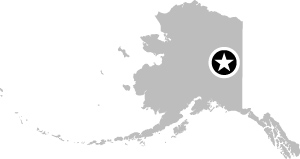U.S.
Alaska
U.S.
Alaska
081
Aurora Borealis, Fairbanks, AK
 64° 50Ⲡ16ⳠN, 147° 42Ⲡ59ⳠW
64° 50Ⲡ16ⳠN, 147° 42Ⲡ59ⳠW
![]()
![]()
The Northern Lights
The Aurora Borealis (also called the Northern Lights, and shown in Figure 81-1) appears in the ionosphere in northern latitudes and is visible on dark nights. The light displays are caused by the interaction between the solar wind and the Earthâs magnetosphere (see sidebar). To see the northern aurora, it is necessary to travel far to the northâthe aurora is roughly centered on the Magnetic North Pole (see Chapter 128).
In the U.S., a good place to see the aurora is Fairbanks, Alaska; the nights are dark enough, itâs far enough north, and the city has relatively clear nights in the spring and autumn. The aurora is also visible from northerly parts of eastern Canada, Iceland, and northern Scandinavia.
In Fairbanks, spring and autumn (around the equinoxes) are the best times for aurora viewing because the sky is dark and clear. Youâll have to stay up until local midnight (ignoring daylight savings time, since you want the actual middle of the night as determined by longitude), when the sky is darkest. For best results, escape Fairbanks by driving north until the city ...
Get The Geek Atlas now with the O’Reilly learning platform.
O’Reilly members experience books, live events, courses curated by job role, and more from O’Reilly and nearly 200 top publishers.
Get Mark Richards’s Software Architecture Patterns ebook to better understand how to design components—and how they should interact.

Dive in for free with a 10-day trial of the O’Reilly learning platform—then explore all the other resources our members count on to build skills and solve problems every day.
Start your free trial Become a member now